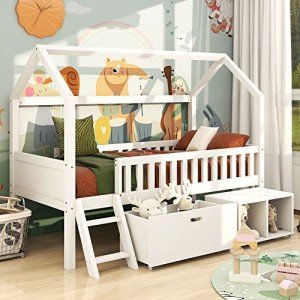A Comprehensive Guide to Children's Bunk Beds: Styles, Benefits, and Safety Considerations
Bunk beds have ended up being a popular option for households wanting to make the most of space and supply a fun sleeping environment for children. With their unique design, they offer a creative and useful service for shared bedrooms, playrooms, and even guest lodging. This article explores the numerous styles of children's bunk beds, their benefits, security factors to consider, and answers some regularly asked questions.
The Allure of Bunk Beds
Kid's bunk beds are more than just space-saving structures; they are likewise an entrance to daring dreams and imaginative play. Below is a detailed examination of their various benefits.
Advantages of Bunk Beds
- Space-Saving: Bunk beds efficiently utilize vertical space, making them an ideal option for smaller sized spaces.
- Playful Design: Many bunk bed designs consist of slides, tents, and themed elements, stimulating creativity and excitement.
- Partner Sharing: Bunk beds are perfect for brother or sisters sharing a room or accommodating slumber parties.
- Flexible Use: Some designs can be separated into 2 individual beds, providing versatility as children grow.
- Storage Options: Many bunk beds come with integrated drawer storage or shelves, even more improving their usefulness.
Designs of Children's Bunk Beds
The range of bunk beds readily available today caters to different preferences and requirements. Below is an introduction of some popular designs.
| Style | Description | Best For |
|---|---|---|
| Requirement Bunk Bed | A standard style featuring one bed stacked above another. | Brother or sisters sharing a space. |
| Loft Bed | Similar to a bunk bed without the bottom bunk, allows for a work space or play location listed below. | Limited space for play/desk. |
| L-Shaped Bunk Bed | 2 beds arranged in an L-shape, typically with additional areas for storage or play. | Special space layouts. |
| Twin Over Full | A twin bed over a full bed, accommodating different sleep needs. | Growing children and teens. |
| High Sleeper | Stands even greater than a loft bed, normally featuring a desk or play location below. | Older kids requiring more play/desk space. |
| Tent Bunk Bed | Bunk beds with a canopy or tent-like structure, producing a cozy, enjoyable space. | Active and imaginative kids. |
Key Features to Consider
When picking the ideal bunk bed for kids, the following functions are worth considering:
- Material: Bunk beds can be made from wood, metal, or a combination. Each has its unique visual and durability.
- Weight Capacity: Always validate the weight limitation of the bunk bed to ensure it can accommodate your children safely.
- Safety Rails: Ensure the leading bunk has tough rails to avoid falls.
- Ladder Security: A well-designed ladder needs to offer simple and safe access to the upper bunk.
- Ending up: Ensure any surfaces are non-toxic and safe for kids.
Safety Considerations
Security is critical when it comes to kids's bunk beds. The following guidelines need to be followed:
- Age Appropriateness: Generally, children under six years old need to not oversleep the upper bunk due to safety risks.
- Durable Construction: Ensure the frame and products are solid and can support the weight without sagging.
- Routine Maintenance: Periodically examine for loose screws, bolts, or other parts that might require tightening.
- Clear Play Area: Keep the location around the bunk bed free of toys and obstacles to minimize tripping dangers.
Setting Rules for Safe Use
Developing guidelines for bunk bed usage will help make sure security:
- Limit Jumping and Climbing: Children must be recommended versus jumping from the top bunk and getting on the sides.
- Supervising Sleepovers: Monitor young visitors while they are using the bunk bed for the very first time.
- Educate on Ladder Use: Teach how to utilize the ladder safely, emphasizing the significance of dealing with the ladder when going up or down.
Often Asked Questions
1. What Adult Bunk Bed is proper for a child to oversleep the top bunk?
The majority of makers suggest that kids must be at least six years old to oversleep the upper bunk. This standard is created to mitigate the risk of falls.
2. Can bunk beds be tailored?
Yes, lots of makers provide customizable choices, including colors, products, and additional functions like drawers or desks.
3. Are bunk beds safe for weight?
Bunk beds have weight limitations, usually ranging from 200 to 400 pounds, depending on the model and product. Constantly inspect the maker's specifications.
4. How do I maintain and clean a bunk bed?
Regularly examine for loose parts, keep the bed tidy by wiping down surfaces, and guarantee the bed linen is fresh to promote a safe and hygienic sleep environment.
5. Can bunk beds be separated into private beds?
Many bunk beds feature an alternative to separate them into two specific beds, providing long-term adaptability.
Children's bunk beds are more than simple furniture; they are a practical, versatile, and imaginative component of a child's room. With numerous designs readily available and numerous security considerations to bear in mind, parents can select the ideal bed that fits their space, meets their children's needs, and instills a sense of experience. By understanding the benefits, designs, and safety steps related to bunk beds, households can develop a wonderful and safe sleeping environment for their children. Whether for brother or sisters sharing a space or space-saving solutions, bunk beds stay a precious option for many families.

